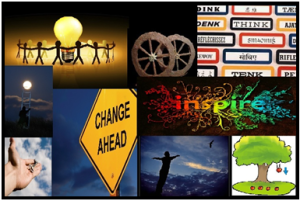One thing is for certain, everyone experiences change. Change, whether anticipated or not, can be difficult. It elicits feelings of excitement, fear, stress and/or happiness. In today’s world, change disrupts the flow of what has been, evolving current situations or making them irrelevant. Those who have thought themselves invincible now must confront vulnerability. Whether broken and bruised or strengthened and motivated, they can continue on their path, look for another way, or quit.
Many IBM executives can attest to the frequently changing nature of the consulting world and how those opportunities (whether favorable or not) were leveraged to accelerate their career path.
In his 14 year consulting career, Srini Attili, a Partner in the US Federal Healthcare Team, experienced a lot of changes as he navigated his career path from a Junior Programmer to an IT specialist to an IT architect to a Client Partner and Capture role. Many of Srini’s career changing moments actually resulted from people believing in him. His credentials and reputation caused people to seek him out for new opportunities, which gave him a chance to prove he could be successful in new territories. In a microwave generation, many find it difficult to be patient and take the time to understand business needs and goals, often shying away from the unfamiliar, but it was the unfamiliar that allowed Srini to grow in the depth and breadth of his knowledge base.
“Instant gratification is good for all, but sometimes you have to be patient, step back and look at it from the perspective of the people who are accountable for the overall delivery and see what impacts them.”
– Srini Attili
Application Innovation Services Leader, Andrew Fairbanks, is no stranger to change either. In the late 90s, Andrew was thriving in his career and enjoying working on a series of short strategic engagements with a variety of higher education clients. After winning a $500 million proposal to design, build, and operate an online university, Andrew was approached to be a part of the delivery team. Making the transition from short term engagements to working on a large complex delivery for a sustained period of time would grow to be something that Andrew enjoyed. Moving past the initial impulse of fear and being open to the risks that come with new engagements would open up a number of opportunities for Andrew that enabled him to move through the ranks from a Program Manager to a Program Executive to a Senior Program Executive.
“When your leadership comes to you and ask you to do something, be willing to take the gamble. They are usually doing it for a reason, because they think it’s in the best interest of your career and it’s what the business really needs of you.”
– Andrew Fairbanks
Many career changing moments find us in a place where we experience new people, subjects, or clients. Speaking with Lori Feller, IBM Interactive Experience and Mobile / Social Business Leader, it was clear that the theme of collaboration repeated throughout her career experiences. A support system is needed to help endure changes, whether planned or unexpected, and being able to identify those resources is critical to managing transitions in one’s career.
“I really couldn’t do it without the support of my mentors, my peers, and the people that I work with everyday.”
-Lori Feller
There will be many defining moments in someone’s career that can either propel or hinder their success. One of the most common ways to deal with change is to adjust your thinking. Approach change as a process – reframe how you think about change and be flexible. Every successful person has encountered unplanned changes at some point in their career. Their success comes from how they dealt with it.
Whenever you encounter change in the workplace:
- Recognize that change does happen
- Be aware of your surroundings and subtle clues that change is coming
- Recognize the stages
- Communicate with others
- Do a self assessment
- Be flexible
- Continue to do your work
- Be positive in actions and attitude
- Maintain your network
- See the big picture
“If we don’t change, we don’t grow. If we don’t grow, we aren’t really living.”
–Gail Sheehy, Author
 This post was written by: Jelece Morris, Consultant for IBM.
This post was written by: Jelece Morris, Consultant for IBM.


